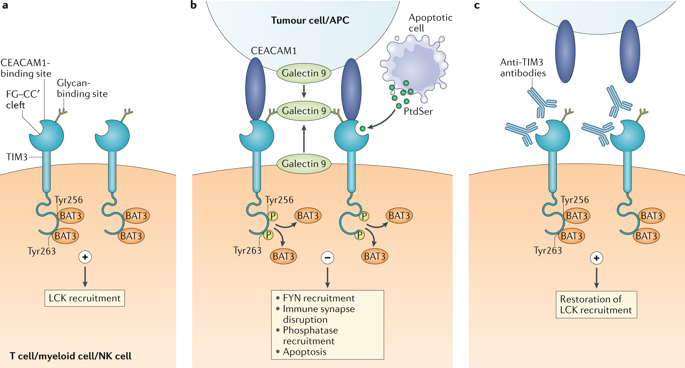当前位置:
X-MOL 学术
›
Nat. Rev. Immunol.
›
论文详情
Our official English website, www.x-mol.net, welcomes your
feedback! (Note: you will need to create a separate account there.)
TIM3 comes of age as an inhibitory receptor.
Nature Reviews Immunology ( IF 67.7 ) Pub Date : 2019-11-01 , DOI: 10.1038/s41577-019-0224-6 Yochai Wolf 1, 2 , Ana C Anderson 1, 2 , Vijay K Kuchroo 1, 2
Nature Reviews Immunology ( IF 67.7 ) Pub Date : 2019-11-01 , DOI: 10.1038/s41577-019-0224-6 Yochai Wolf 1, 2 , Ana C Anderson 1, 2 , Vijay K Kuchroo 1, 2
Affiliation

|
T cell immunoglobulin and mucin domain-containing protein 3 (TIM3), a member of the TIM family, was originally identified as a receptor expressed on interferon-γ-producing CD4+ and CD8+ T cells. Initial data indicated that TIM3 functioned as a 'co-inhibitory' or 'checkpoint' receptor, but due to the lack of a definable inhibitory signalling motif, it was also suggested that TIM3 might act as a co-stimulatory receptor. Recent studies have shown that TIM3 is part of a module that contains multiple co-inhibitory receptors (checkpoint receptors), which are co-expressed and co-regulated on dysfunctional or 'exhausted' T cells in chronic viral infections and cancer. Furthermore, co-blockade of TIM3 and programmed cell death 1 (PD1) can result in tumour regression in preclinical models and can improve anticancer T cell responses in patients with advanced cancers. Here, we highlight the developments in understanding TIM3 biology, including novel ligand identification and the discovery of loss-of-function mutations associated with human disease. In addition, we summarize emerging data from human clinical trials showing that TIM3 indeed acts as a 'checkpoint' receptor and that inhibition of TIM3 enhances the antitumour effect of PD1 blockade.
更新日期:2019-11-01































 京公网安备 11010802027423号
京公网安备 11010802027423号